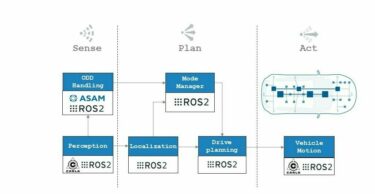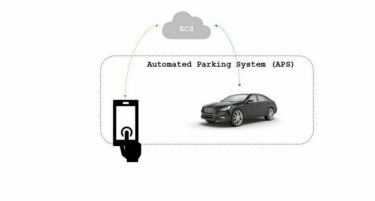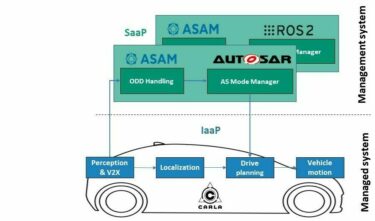Read next
Automatic Parking System
Well-designed architectures guarantee Safety in Automated Driving Systems
The standardized architecture of the Fraunhofer IKS integrates any automated driving function into an existing automated verhicle.



© iStock/mseidelch
Driving is highly enjoyable, but looking for a parking spot, driving there, parking the vehicle, and walking to your destination is not only time consuming, but also stressful and annoying. Have you ever thought about purchasing a valet parking service to take care of the parking task for you? With the Automated Parking System developed at the Cognitive Systems Engineering department of the Fraunhofer IKS this has become reality.
The Fraunhofer-Institute for Cognitive Systems IKS has designed a standardized architecture to offer and ease integration of any automated driving function into an existing automated vehicle.
Behind the solution lies a standardized software architecture divided in two different systems: the managed system and the management system. The managed system is responsible for driving the vehicle based on the path planned and the environment information obtained from the perception components. The management system is added to adapt all the vehicle manoeuvres based on the context in which is being operated. The main goal is to guarantee safety while preserving the Automated Driving functionality, the so-called utility.

© Fraunhofer IKS
The standardized software architecture divided in two different systems: the managed system and the management system.
The software architecture is based on the classic sense-plan-action paradigm, as in the ISO/TR-4804 technical report, that allows the system to interact closely with the environment and adapt quickly to the changing conditions that have been considered in its development. This allows the system itself to decide how to act on its own, making it resilient and flexible at the same time.
To be easily integrated into the current managed system of different providers, the management system has been developed according to industry standards: AUTOSAR Classic Platform for the system architecture [1] and ASAM OpenODD for the ODD modelling [2]. In [3] the software architecture has been deployed for an Automated Parking System (APS) in ROS2 and integrated in the CARLA simulation environment for validation.

© Fraunhofer IKS
ROS2 deployment of software architecture integrated in CARLA.
The APS assumes an external service provider and an app that manages parking spots. Once the user exits the car and selects the desired parking space, the APS does the rest: Drives autonomously to the reserved parking spot and executes the correct parking manoeuvre respecting the driving rules.

© Fraunhofer IKS
The APS drives autonomously to the reserved parking spot and executes the correct parking manoeuvre respecting the driving rules.
Privacy warning: With the click on the play button an external video from www.youtube.com is loaded and started. Your data is possibly transferred and stored to third party. Do not start the video if you disagree. Find more about the youtube privacy statement under the following link: http://www.youtube.com/t/privacy_at_youtube
The automated parking functionality has been designed to operate in specific weather conditions for which sensor data can be trusted using the Operational Design Domain (ODD) Taxonomy in BSI PAS 1883. The goal is to optimize utility and guarantee the safety of the system for the operating conditions for which it has not been designed. Whenever an exit condition of an ODD is detected, the managed system is degraded by the Autonomous Driving (AS) Mode Manager. The safe mode consists of aborting the parking manoeuvres and redirecting the vehicle to a safe area of the city for the vehicle to stop.
Privacy warning: With the click on the play button an external video from www.youtube.com is loaded and started. Your data is possibly transferred and stored to third party. Do not start the video if you disagree. Find more about the youtube privacy statement under the following link: http://www.youtube.com/t/privacy_at_youtube
The presented architecture is generic and supports incremental development in the CARLA virtual vehicle only by adapting the requirements to the management system and enhancing the implementation of new functionality in the managed system.

© Fraunhofer IKS
Modular and extendible architecture for automated driving systems.
Fraunhofer IKS offers support for the design of the management system as a service for OEM, automotive suppliers or other companies. The customer only needs to specify the Operational Design Domains and define the variability (manoeuvres) allowed for the ODDs. With that information, we can implement the communication and the mode switching either in AUTOSAR Classic Platform or in ROS2.
Privacy warning: With the click on the play button an external video from www.youtube.com is loaded and started. Your data is possibly transferred and stored to third party. Do not start the video if you disagree. Find more about the youtube privacy statement under the following link: http://www.youtube.com/t/privacy_at_youtube
References
[1] Software Architectural Design for Safety in Automated Driving Systems. Student: Yassine El Kabdani
[2] Software Architectural Design for Safety in Automated Parking System. Student: Roger Tremosa
[3] ROS2 versus AUTOSAR: automated PARKING system case-study. Student: Kenneth Casado
This project is funded by the Bavarian State Ministry of Economic Affairs, Regional Development and Energy as part of the project Support for the Thematic Development of the Institute for Cognitive Systems.


